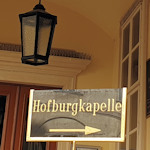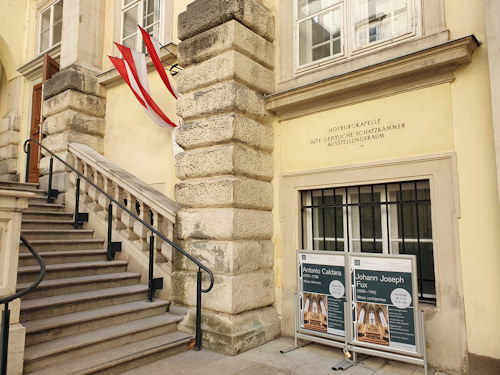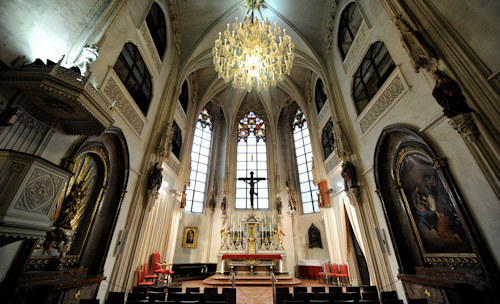
A bonus treat for any visitor to the Hofburg palace is the Hofburgkapelle (or simply Burgkapelle): a chapel that served dozens of Imperial families through the ages. And some of Vienna’s best singers and musicians now perform within, too.
- Small chapel, but big history
- Parts of the Gothic original remain
- Located next to the Imperial Treasury
- Home to the prestigious Wiener Hofmusikkapelle
- The ensemble performs at Holy Mass services
- See also:
Chapel and concert venue

(The steps leading up to the Hofburgkapelle)
The Hofburg complex has its giant gateways, huge monuments, royal apartments and more. Not to mention the magnificent Imperial Treasury in the Schweizerhof courtyard, home to garnets the size of goose eggs and other baubles from the Habsburg dynasty.
That same Schweizerhof courtyard has another historical jewel tucked away behind an otherwise innocuous entrance.
A set of steps takes you up into the Hofburgkapelle, a large chapel that makes most churches in Vienna feel positively post-modern.
This Imperial Court Chapel traces its roots back to at least the 13th century, even if its exact position (probably) and architecture (definitely) has shifted with the centuries.

(The Imperial Court Chapel; press photo by Regina Aigner, BKA)
The chapel you see today likely appeared more or less in its current position in the early 15th-century under the auspices of Albrecht V (1397-1439), the Habsburg Duke of Austria (among other titles, which the Habsburgs collected much like we collect stamps).
Inside resonates with the hand of history.
As you sit surrounded by balconies, you begin to imagine what whispered conversations might have taken place within, as various Emperors sought solace and divine help during wars with the Ottomans / Prussians / Swedes / French… (delete as historically appropriate).
The body of Emperor Ferdinand I apparently spent a year in the Burgkapelle after his death in 1564. Some 350 years later, visitors to the chapel would have paid their last respects to Archduke Franz Ferdinand, whose assassination in Sarajevo started the chain of events that led to WWI.

(The rear of the chapel seen from outside)
As so often with such buildings, various changes and renovations took place through the centuries, though many Gothic elements remain.
The capstones in the roof, the coloured figures on the walls around the main altar, and a wooden statue of the Virgin Mary all date back to the late 1300s or early 1400s, for example.
Much of the interior stems from major alterations conducted during the 1700s and early 1800s. The tabernacle, for example, was apparently designed by Nikolaus Pacassi (1716-1790), the man also responsible for finishing off Schönbrunn Palace.
Given the dates of those changes, you might expect considerable Baroque finery, but the chapel retains a clear Gothic flavour.
Perhaps the renovators wished to add emphasis to the historical legitimacy of the Habsburg dynasty, who rarely left anything to chance when it came to physical manifestations of their power.

(Wedding of Archduke Franz with Elisabeth Wilhelmine von Württemberg in the Burgkapelle on January 6th, 1788; copper engraving by Jakob Adam from a drawing by Johann Christian Sambach; 1788; Wien Museum Inv.-Nr. 220106; excerpt reproduced with permission under the terms of the CC0 licence)
Concerts
The Hofburgkapelle also serves as the home of the rather prestigious Wiener Hofmusikkapelle, which translates as the Vienna Court Music Ensemble.
Ticketed Sunday performances by the ensemble (mid-September to June) are in the context of a formal Holy Mass in the Roman Catholic tradition. In other words, those are not concerts in the traditional sense of the word.
During the Mass, the Hofmusikkapelle performs the liturgical musical elements from the top gallery (out of sight of much of the congregation), though the event ends with a vocal musical composition performed by ensemble members from the Vienna Boys’ Choir in front of the altar.
Helpfully, a leaflet (in English) provides an introduction to the meaning and structure of the Roman Catholic Holy Mass to those visitors who are non-Christians.
The chapel also hosts occasional other (classical) concerts. Find a full schedule for all the concerts at the Hofmusikkapelle website.
Tickets & visitor tips
You can pop your head into the Hofburgkapelle for free, though opening times are restricted: check that official website for days and times.
For the musical performances, you need a ticket (information also available through the website).
As mentioned earlier, the surrounding Hofburg area has much to offer the visitor too.
Many of Vienna’s other church institutions also feature classical music in a suitably inspiring setting, whether through services or concerts. I have a few suggestions here, plus articles on some of the other prominent churches in the city (one or two even older than the Hofburgkapelle).
How to get to the chapel
Unsurprisingly (and fortunately) the authorities have not put in tram lines or subway stations here. But the Hofburgkapelle is easy to reach.
First find your way to the Hofburg complex in the centre of town.
This typically means a short stroll from a subway station (like Stephansplatz on the U1 and U3 or Herrengasse on the U3), the D, 1, 2 or 71 trams (get off at the Burgring stop) or bus lines 1A or 2A to Michaelerplatz or Habsburgergasse.
(You’ll probably pass through the Hofburg on a city centre walk: it’s Part 2 of my self-guided walking tour suggestion for Vienna, for example.)
Most people will then enter either from:
- The Heldenplatz square side: walk straight through into the complex until you reach the courtyard with the large monument to Emperor Franz II/I. Look right to see the decorated Schweizertor gate. Go through that gate to enter the Schweizerhof and find the chapel on your right.
- The Michaelerplatz square side: ditto, expect now the Schweizertor will be on your left.
Address: Hofburg-Schweizerhof, 1010 Vienna